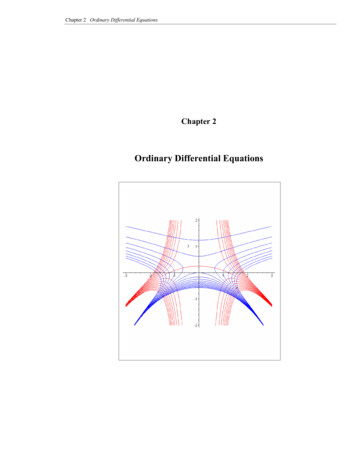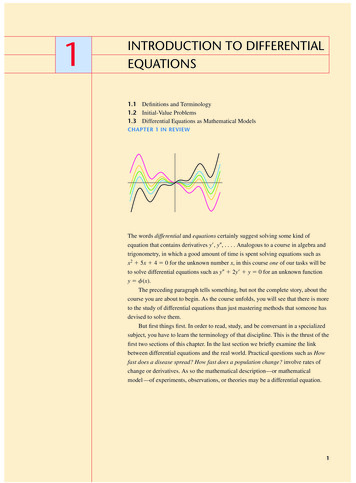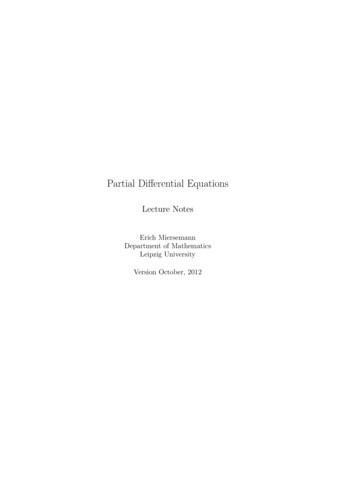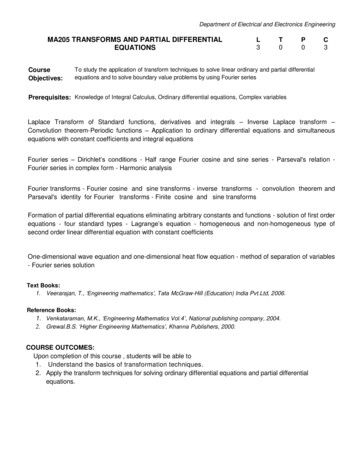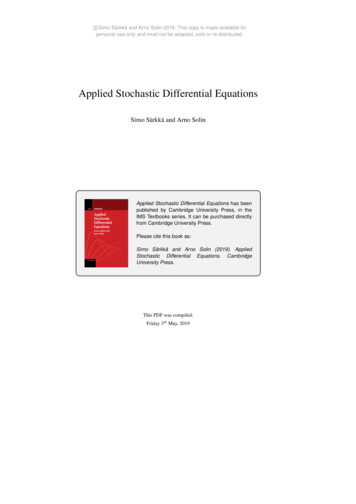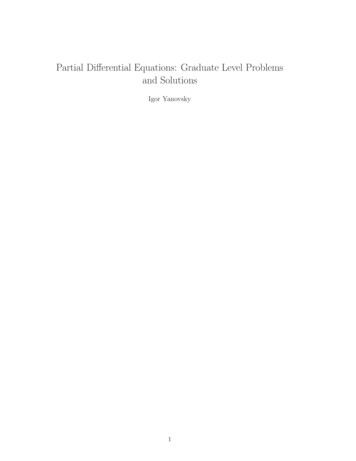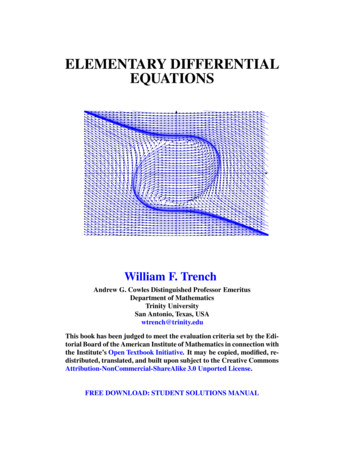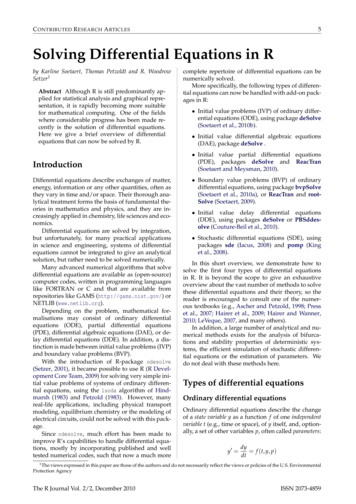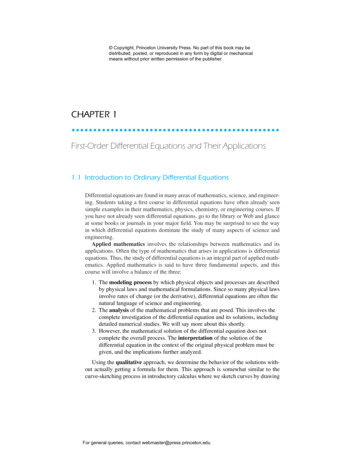
Transcription
Copyright, Princeton University Press. No part of this book may bedistributed, posted, or reproduced in any form by digital or mechanicalmeans without prior written permission of the publisher.CHAPTER 1 First-Order Differential Equations and Their Applications1.1 Introduction to Ordinary Differential EquationsDifferential equations are found in many areas of mathematics, science, and engineering. Students taking a first course in differential equations have often already seensimple examples in their mathematics, physics, chemistry, or engineering courses. Ifyou have not already seen differential equations, go to the library or Web and glanceat some books or journals in your major field. You may be surprised to see the wayin which differential equations dominate the study of many aspects of science andengineering.Applied mathematics involves the relationships between mathematics and itsapplications. Often the type of mathematics that arises in applications is differentialequations. Thus, the study of differential equations is an integral part of applied mathematics. Applied mathematics is said to have three fundamental aspects, and thiscourse will involve a balance of the three:1. The modeling process by which physical objects and processes are describedby physical laws and mathematical formulations. Since so many physical lawsinvolve rates of change (or the derivative), differential equations are often thenatural language of science and engineering.2. The analysis of the mathematical problems that are posed. This involves thecomplete investigation of the differential equation and its solutions, includingdetailed numerical studies. We will say more about this shortly.3. However, the mathematical solution of the differential equation does notcomplete the overall process. The interpretation of the solution of thedifferential equation in the context of the original physical problem must begiven, and the implications further analyzed.Using the qualitative approach, we determine the behavior of the solutions without actually getting a formula for them. This approach is somewhat similar to thecurve-sketching process in introductory calculus where we sketch curves by drawingFor general queries, contact webmaster@press.princeton.edu
2 Chapter 1 Copyright, Princeton University Press. No part of this book may bedistributed, posted, or reproduced in any form by digital or mechanicalmaxima, minima,concavity changes, and so on. Qualitative ideas will be discussedmeans without prior written permission of the publisher.in Section 1.4 and Chapters 4, 5, and 6.Using the numerical approach, we compute estimates for the values of theunknown function at certain values of the independent variable. Numerical methodsare extremely important and for many difficult problems are the only practicalapproach. We discuss numerical methods in Section 1.5. The safe and effective use ofnumerical methods requires an understanding of the basic properties of differentialequations and their solutions.Most of this book is devoted to developing analytical procedures, that is, obtaining explicit and implicit formulas for the solutions of various ordinary differentialequations. We present a sufficient number of applications to enable the reader tounderstand how differential equations are used and to develop some feeling for thephysical information they convey.Asymptotic and perturbation methods are introduced in more advanced studiesof differential equations. Asymptotic approximations are introduced directly from theexact analytic solutions in order to get a better understanding of the meaning of theexact analytic solutions. Unfortunately, many problems of physical interest do nothave exact solutions. In this case, in addition to the previously mentioned numericalmethods, approximation methods known as perturbation methods are often useful forunderstanding the behavior of differential equations.In this book, we use the phrase “differential equation” to mean an ordinary differential equation (or a system of ordinary differential equations. An ordinary differentialequation is an equation relating an unknown function of one variable to one or morefunctions of its derivatives. If the unknown x is a function of t, x x(t), then examplesof ordinary differential equations aredx t 7 cos x,dtd 2xdx x ,2dtdtd 4x 5x 5 .dt 4(1)The order of a differential equation is the order of the highest derivative of theunknown function (dependent variable) that appears in the equation. The differentialequations in (1) are of first, second, and fourth order, respectively. Most of theequations we shall deal with will be of first or second order.In applications, the dependent variables are frequently functions of time, whichwe denote by t. Some applications such as1.2.3.4.population dynamics,mixture and flow problems,electronic circuits,mechanical vibrations and systemsare discussed repeatedly throughout this text. Other applications, such as radioactivedecay, thermal cooling, chemical reactions, and orthogonal trajectories, appear onlyas illustrations of more specific mathematical results. In all cases, modeling, analysis,and interpretation are important.For general queries, contact webmaster@press.princeton.edu
3First-Order Differential Equations and Their Applications Copyright, Princeton University Press. No part of this book may bedistributed, posted, or reproduced in any form by digital or mechanicalLet us brieflyconsider the following motivating population dynamics problem.means without prior written permission of the publisher.Example 1.1.1 Population Growth ProblemAssume that the population of Washington, DC, grows due to births and deaths at therate of 2% per year and there is a net migration into the city of 15,000 people peryear. Write a mathematical equation that describes this situation. SOLUTION. We letx(t) population as a function of time t.(2)dx rate of change of the population.dt(3)From calculus,In this example, 2% growth means 2% of the population x(t). Thus, the populationof Washington, DC satisfiesdx 0.02x 15,000.dt(4) Equation (4) is an example of a differential equation, and we develop methods tosolve such equations in this text. We will discuss population growth models in moredepth in Section 1.8 and Chapters 5 and 6.In a typical application, physical laws often lead to a differential equation. As asimple example, we will consider later the vertical motion x(t) of a constant mass.2Newton’s law says that the force F equals the mass m times the acceleration ddt x2 :md 2x F.dt 2(5)If the forces are gravity mg and a force due to air resistance proportional to thevelocity dxdt , then the position satisfies the second-order differential equationmd 2xdx mg c ,dt 2dt(6)where c is a proportionality constant determined by experiments. However, if inaddition the mass is tied to a spring that exerts an additional force kx satisfyingHooke’s law, then we will show that the mass satisfies the following second-orderdifferential equation:mdxd 2x mg kx c .2dtdtFor general queries, contact webmaster@press.princeton.edu(7)
4 Chapter 1 Copyright, Princeton University Press. No part of this book may bedistributed, posted, or reproduced in any form by digital or mechanicalIn the main bodyof the book, we will devote some effort to the modeling process bymeans without prior written permission of the publisher.which these differential equations arise, as well as learning how to solve these typesof differential equations easily.We will also see that a typical electronic circuit with a resistor, capacitor, andinductor can often be modeled by the following second-order differential equation:Ld 2i1di R i f (t).dt 2dt C(8)Here the unknown variable is i(t), the time-dependent current running through thecircuit. We will present a derivation of this differential equation, and you will learn themeaning of the three positive constants R, L, and C (this is called an RLC circuit).For example, R represents the resistance of a resistor, and we will want to studyhow the current in the circuit depends on the resistance. The right-hand side f (t)represents something that causes current in the circuit, such as a battery.Physical problems frequently involve systems of differential equations. For example, we will consider the salt content in two interconnected well-mixed lakes, allowingfor some inflow, outflow, and evaporation. If x(t) represents the amount of salt inone of the lakes and y(t) the amount in the other, then under a series of assumptionsdescribed in the book, the following coupled system of differential equations is anappropriate mathematical model:dx 1yx, 2 3100dt2100dy5 yy . 3100 2 100dt(9)1.2 The Definite Integral and the Initial Value ProblemThis chapter is concerned with first-order differential equations, in which the firstderivative of a function x(t) depends on the independent variable t and the unknownsolution x. If dxdt is given directly in terms of t and x, the differential equation has theformdx f (t, x).dt(1)In later sections, we will discuss a number of applications of first-order equations such as growth and decay problems for populations, radioactive decay, thermalcooling, mixture problems, evaporation and flow, electronic circuit theory, and severalothers. In these applications, some care is given to the development of mathematicalmodels.A solution of the differential equation (1) is a function that satisfies the differentialequation for all values t of interest:dx(t) f (t, x(t))dtfor all t.For general queries, contact webmaster@press.princeton.edu
First-Order Differential Equations and Their Applications5 Copyright, Princeton University Press. No part of this book may beposted, or reproduced in any form by digital or mechanicalExample 1.2.1distributed,Showing Thata Function Is a Solutionmeans without prior written permission of the publisher.2Verify that x 3et is a solution of the first-order differential equationdx 2tx.dt(2)2SOLUTION. We substitute x 3et in both the left- and right-hand sides of (2). On22dthe left we get dt(3et ) 2t (3et ), using the chain rule. Simplifying the right-handside, we find that the differential equation (2) is satisfied 226tet 6tet ,2which holds for all t. Thus x 3et is a solution of the differential equation (2). Before beginning our general development of first-order equations in Section 1.4,we will discuss some differential equations that can be solved with direct integration. These special cases will be used to motivate and illustrate some of the laterdevelopment.1.2.1 The Initial Value Problem and the Indefinite IntegralThe simplest possible first-order differential equation arises if the function f (t, x)in (1) does not depend on the unknown solution, so that the differential equation isdx f (t).dt(3)Solving (3) for x is just the question of antidifferentiation in calculus. Although (3)can be solved by an integration, we can learn some important things concerning moregeneral differential equations from it that will be useful later.Example 1.2.2 Indefinite IntegrationConsider the simple differential equation,dx t 2.dt(4)1x t 3 c,3(5)By an integration, we obtainwhere c is an arbitrary constant. From this example, we see that differential equationsusually have many solutions. We call (5) the general solution of (4), since it is aformula that gives all solutions. Because x depends on t, sometimes we use thenotation x(t). Often, especially in applications, we are interested in a specific solutionof the differential equation to satisfy some additional condition. For example, supposeFor general queries, contact webmaster@press.princeton.edu
6 Chapter 1 Copyright, Princeton University Press. No part of this book may bedistributed, posted, or reproduced in any form by digital or mechanicalwe are givenmeansthat x 7 at t 2. This is written mathematically as x(2) 7 and calledwithout prior written permission of the publisher.an initial condition. By letting t 2 and x 7 in (5), we get7 8 c,3so that the constant c is determined to be c 133 . Thus, the unique solution of thedifferential equation that satisfies the given initial condition is113x t3 .33 More generally, we might wish to solve the differential equationdx f (t),dt(6)x(t0 ) x0 .(7)subject to the initial conditionWe introduce the symbol t0 for the value of t at which the solution is given. Oftent0 0, but in the previous example, we had t0 2 and x0 7. We refer to (6) withthe initial condition (7) as the initial value problem for the differential equation. Wecan always write a formula for the solution of (6) using an indefinite integral x f (t)dt c.(8)Equation (5) is a specific example of (8). If we can obtain an explicit indefiniteintegral (antiderivative) of f (t), then this initial value problem can be solved likeExample 1.2.1. Explicit integrals of various functions f (t) may be obtained by usingany of the various techniques of integration from calculus. Tables of integrals orsymbolic integration algorithms such as MAPLE or Mathematica that are availableon more sophisticated calculators, personal computers, or larger computers may beused. However, if one cannot obtain an explicit integral, then it may be difficult touse (8) directly to satisfy the initial conditions.1.2.2 The Initial Value Problem and the Definite IntegralA definite integral should usually be used to solve the differential equation dxdt f (t)if an explicit integral is not used. The result can automatically incorporate the giveninitial condition x(t0 ) x0 . If both sides of the differential equation (6) are integratedwith respect to t from t0 to t, we get tt0dxdt dt tf (t)dt,t0 where we have introduced the dummy variable t. The left-hand side equals x(t) t tt tx(t) x(t0 ), since the antiderivative ofdxdt0is x. We obtain the same result cancelingFor general queries, contact webmaster@press.princeton.edu
First-Order Differential Equations and Their Applications7 Copyright, Princeton University Press. No part of this book may bet, sincedxdistributed, posted, or reproduced in any form by digital or mechanicaldt dx. Thus, we havedt means without prior written permission of the publisher. x(t) x(t0 ) tor equivalently,f (t)dt,t0 x(t) x(t0 ) (9)tf (t)dt.t0Note that x(t0 ) x0 sincebe used. We have chosen t. t0t0f (t)dt 0. Any dummy variable of integration mayExample 1.2.3 Example with a Definite IntegralSolve the differential equationdx2 e t ,dt(10)subject to the initial condition x(3) 7.SOLUTION. The function e t does not have any explicit antiderivative. Thus, ifwe want to solve (10), we use definite integration from t0 3, where x0 7. Then (9) is 2 tx 7 2e t dt,3and the solution of the initial value problem is x 7 t2e t dt.(11)3 22The function e t is important in probability, since (1/ 2π )e t /2 is the famousnormal curve. There are many situations in which it is desirable to use a definite integral ratherthan an explicit antiderivative:1. It is sometimes difficult to obtain an explicit antiderivative, and a formulalike (11) suffices.2. For some f (t) (as in the previous example), it is impossible to obtain anexplicit antiderivative in terms of elementary functions.3. The function f (t) might be expressed only by some data, in which case thedefinite integral (9) represents the area under the curve f (t) and can beevaluated by an appropriate numerical integration method such as Simpson’sor the trapezoid rule.It is difficult to give general advice valid for all problems. If an integral is an elementary integral, then the explicit integral should be used. However, what is elementaryto one person is not necessarily elementary to another. With the wide availability ofcomputers, a definite integral can usually be evaluated by a numerical integration.For general queries, contact webmaster@press.princeton.edu
8 Chapter 1 Copyright, Princeton University Press. No part of this book may bedistributed, posted, or reproduced in any form by digital or mechanicalGeneral SolutionUsing a Definite Integralmeans without prior written permission of the publisher.Alternatively, in solving for the general solution ofdx f (t),dt(12)we may use the definite integral starting at any point a. In this case, we obtain thegeneral solution of (12) as tf (t)dt c.(13)x aThere appear to be two arbitrary constants, c and the lower limit of the integral ain (13). However, it can be shown that this is equivalent to one arbitrary constant. Inpractice, the lower limit a is often chosen to be the initial value of t so that a t0 . Tosee that (13) actually solves the differential equation (12), it is helpful to recall thefundamental theorem of calculus: t df (t)dt f (t).(14)dta1.2.3 Mechanics I: Elementary Motion of a Particlewith Gravity OnlyElementary motions of a particle are frequently described by differential equations.Simple integration can sometimes be used to analyze these elementary motions. Forthe one-dimensional vertical motion of a particle, we recall from calculus thatPosition x(t),dx,dtdv d 2 xAcceleration a(t) 2.dtdtVelocity v(t) Newton’s law of motion (ma F ) will yield a differential equation d 2xdxm 2 F x,,t ,dtdt(15)(16)where m is the mass and F is the sum of the applied forces, and we have allowedthe forces to depend on position, velocity, and time. Equation (16) is a second-orderdifferential equation, which we will study later in the book.There are no techniques for solving (16) in all cases. However, (16) can be solvedby simple integration if the force F does not depend on x and dxdt . As an example,suppose that the only force on the mass is due to gravity. Then it is known thatF mg, where g is the acceleration due to gravity. The minus sign is introducedbecause gravity acts downward, toward the surface of the earth. Here we are takingthe coordinate system so that x increases toward the sky. The magnitude of the forceFor general queries, contact webmaster@press.princeton.edu
First-Order Differential Equations and Their Applications9 Copyright, Princeton University Press. No part of this book may bedistributed, posted, or reproduced in any form by digital or mechanicaldue to gravity,mg, is called the weight of the body. Near the surface of the planetmeans without prior written permission of the publisher.earth, g is approximately g 9.8 m/s2 in the mks system used by most of the world(g 32 ft/s2 when feet are used as the unit of length instead of meters). If we assumethat we are interested in a mass that is located sufficiently near the surface of the earth,then g can be approximated by this constant. With the only force being gravity, (16)becomesmd 2x mg,dt 2or equivalently,d 2x g,dt 2(17)since the mass m cancels. Integrating (17) yieldsdx gt c1 ,dt(18)where c1 is an arbitrary constant of integration. We assume that the velocity at t 0is given and use the notation v0 for this initial velocity. Sincev(t) gt c1from (18), evaluating (18) at t 0 gives v0 c1 . Thus, the velocity satisfiesdx gt v0 .dt(19)The position can be determined by integrating the velocity (19) to give1x gt 2 v0 t c2 ,2(20)where c2 is a second integration constant. We also assume that the position x0 at t 0is given initially. Then, evaluating (20) at t 0 gives x0 c2 , so that1x gt 2 v0 t x0 .2(21)Equations (19) and (21) are well-known formulas in physics and are used to solvefor quantities such as the maximum height of a thrown object. We do not recommendmemorizing (19) or (21). Instead, they should be derived in each case from thedifferential equation (17). If the applied force depends only on time and is not constant,then the formulas for velocity and position may be obtained by integration. If theFor general queries, contact webmaster@press.princeton.edu
10 Chapter 1 Copyright, Princeton University Press. No part of this book may bedistributed, posted, or reproduced in any form by digital or mechanicalapplied forcemeansdependson other quantities, solving the differential equation is not sowithout prior written permission of the publisher.simple. We describe some more difficult problems in Section 1.11 and Chapter 2.Example 1.2.4 Motion with GravitySuppose a ball is thrown upward from ground level with velocity v0 and the onlyforce is gravity. How high does the ball go before falling back toward the ground? SOLUTION. The differential equation (as before) is (17):d 2x g.dt 2(22)The initial conditions are that x 0 and dxdt v0 at t 0. By successive integrationsof (22) and by applying the initial conditions, we obtaindx gt v0dt(23)1x gt 2 v0 t.2(24)andFrom (24), the height is known as a function of time. To determine the maximumheight, we must first determine the time at which the ball reaches this height. Fromcalculus, the maximum of a function x x(t) occurs at a critical point where dxdt 0.At the maximum height, the ball has stopped rising and has not started to fall, so thevelocity is zero. Thus, the time of the maximum height is determined from (23):0 gt v0 ,or equivalently,t v0.g(25)When this time (25) is substituted into (24), a formula for the maximum height y isobtained: 2 v2v0 v021v01 v0 1 0 .(26)y g2ggg22g Example 1.2.5 Car BrakingSuppose that a car is going 76 m/s when brakes are applied at t 2 s. Suppose thatthe nonconstant deceleration is known to be a 12t 2 . Determine the distance thecar travels.SOLUTION. Let x measure the distance traveled once the brakes are applied. Thedifferential equation is d 2x 12t 2 .dt 2For general queries, contact webmaster@press.princeton.edu(27)
First-Order Differential Equations and Their Applications11 Copyright, Princeton University Press. No part of this book may bedistributed, posted, or reproduced in any form by digital or mechanicalBy integrating(27) we obtainmeans without prior written permission of the publisher.dx 4t 3 c1 .dt(28)By integrating (28) again, we obtainx t 4 c1 t c2 .The initial conditions are x 0 andto (28) givesdxdt(29) 76 when t 2. The initial velocity applied76 4(2)3 c1 32 c1 ,so that c1 108. The initial position applied to (29) gives0 24 c1 t c2 16 216 c2 ,and c2 200. To determine the distance the car travels, we note that the car stopswhen the velocity is zero. That is,dx 4t 3 108 0,dtso that the stopping time is t 3 27 or t 3. Then the distance traveled at time t 3is given by substituting t 3 into (29):x 34 108(3) 200 81 324 200 43 m. ExercisesIn Exercises 1–8, verify that the given function x is a solution of the differentialequation.dx 3x 3.dtxdxx t 2, 2 .dttdxxx t 1, .dtt 1dxx2x t 4, 4 5 .dttdx2x et , 2tx.dtdxx 3e4t 2, 4x 8.dtdxx e 2t , 2e2t x 2 .dtdx x 3x t 3, .dtt1. x 2e3t 1,2.3.4.5.6.7.8.--continued--For general queries, contact webmaster@press.princeton.edu
First-Order Differential Equations and Their Applications 5 Example 1.2.1 Showing That a Function Is a Solution Verify that x 3et2 is a solution of the first-order differential equation dx dt 2tx. (2) SOLUTION.Wesubstitutex 3et 2 inboththeleft-andright-handsidesof(2). On the left we get d dt (3e t2) 2t(3e ), using the chain rule.Simplifying the right-hand

